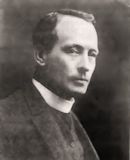The Reverend A.H. Hildesley 1857-1939
3rd Principal of Sanawar

Reverend Alfred H
Hildesley came to Sanawar on April 1st 1884 from the Bishop Cotton
School for Boys in Bangalore where he had been Warden since 1882. He was
accompanied by his young wife Alice and three daughters Audrey, Avis and
Dorothy. It was not till 1912, some twenty eight years later that he
finally laid down his new and onerous charge as Principal and Chaplain of
the Asylum . When he came, educational standards were low, discipline was
rough and the school grossly under-staffed; there were indeed, only eight
teaching staff to five hundred children and some of these quite
unqualified. The task before him might well have deterred a more timid
man, but Mr. Hildesley threw himself wholeheartedly into his work and,
ultimately, was able to overcome these difficulties which had first
appeared insuperable. But it was no easy matter. Radical changes in
outlook and education could not be effected without opposition. The boys
did not take kindly to his ideas, and on one noteworthy occasion went on
strike and marched down to Kalka. Mr. Hildesley met the situation with
great tact and skill and never again was there a recrudescence of
indiscipline.
Academically, Mr. Hildesley was a man of many interests, chief
among them being Music and English Literature. His interests were
reflected in the School, and the Glee Club, which he founded in I885,
flourished under his encouragement.
It was during his long tenure that many of the original School
buildings were repaired, completely rebuilt or refurbished and their
ageing shingle roofs replaced with more durable corrugated iron. Several
new buildings, including the Boy's School, (now Gaskell Hall), the
new Band Room and two new water reservoirs were constructed. He oversaw
the move of the old School Cemetery to its present site beyond
Moti's Corner on the old bridle path to Dharampur in 1886. It was
he, too, who first conceived the boys' playing field and in about
1904, "Big Plain", (now Barne's) was born. He was also responsible
for the planting of many "hundreds of trees and thousands of cuttings"
(sic) all over the hillside, and the myriads of naturalized
Dahlias and carpets of Cosmos that one sees every Spring and Summer
today, are believed to be part of his legacy.
He reigned in Sanawar for over a quarter of a century and served under
three sovereigns. His children grew up on the hilltop. Sadly, one died
there and was buried in the School Cemetery. Another was born there and
two were married in the Chapel. On his retirement, he was awarded the
Kaiser-i-Hind Gold Medal for his labours for the welfare of Sanawar. He
was, however, too indefatigable to remain idle and, on return to
England, accepted the incumbency of Wyton in Huntingdonshire where he
spent most of his remaining days. He was of great service to John
Drinkwater when the latter was preparing a biography of parliamentarian
Charles James Fox and the author acknowledged his debt.
He retired as Rector of All Saint's Parish Church, Wyton in about
1925 and died at his home in Buckley, St. Neots, Huntingdonshire on 19th
April 1939 at the age of 81. Evidently, he had been ailing for some time
and his end was not unexpected. His was a life given to Service and we
pay our humble tribute in these pages.
D.V. Boddington
(LRMS Sanawar 1942-1947)
23 April 2002
Adapted from an article in the midsummer edition of the Sanawarian
Magazine, November 1939.